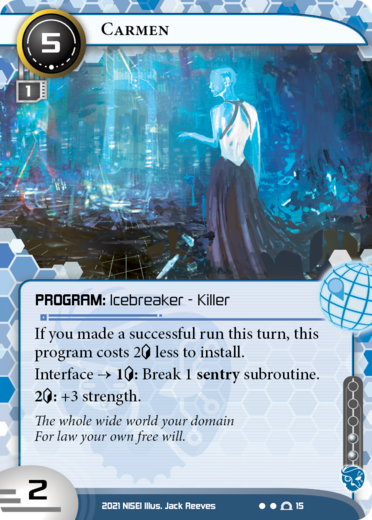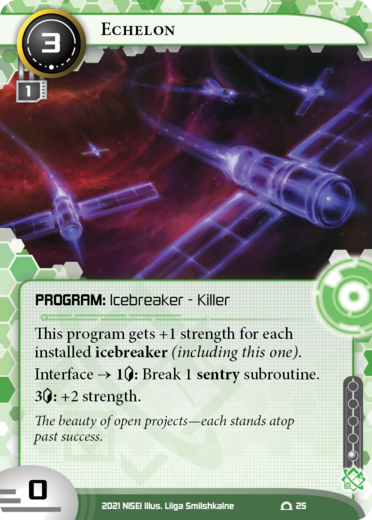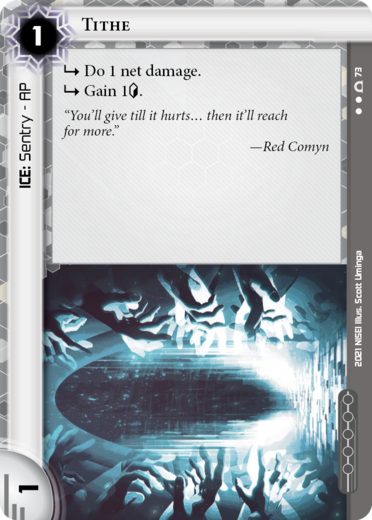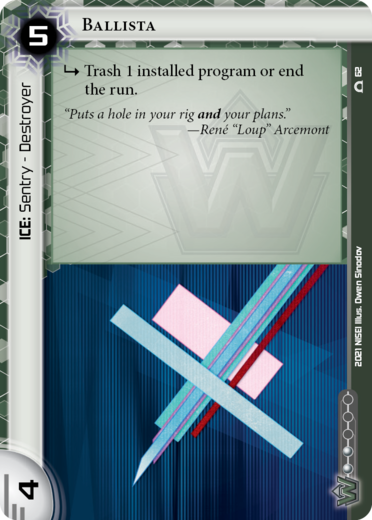Is there an ice subtype Runners fear more than “sentry”? Whereas barriers typically end the run in a straightforward fashion, and code gates introduce all manner of complications, sentries mess with the Runner directly. Clever Runners know that running without a killer—an icebreaker that specializes in taking down sentries—means they risk taking tags, losing programs, or even being flatlined by a sentry’s vicious subroutines.
In this article, I’m going to introduce the two killers in System Gateway, and two of the sentries they may face off against—one of which might be among the best sentries in the game. I’ll attempt, with mixed results, to suggest some ways you might look at including them in decks, and where I think they might carve a niche for themselves. (Disclaimer: All deckbuilding decisions are at your own risk. Team NISEI does not take responsibility for any adverse reactions you may have to following deckbuilding advice in this article.)
The killers: Unconfidential potential
Bukhgalter is widely considered the best killer in the game right now. It was important in playtesting to create alternatives that could carve out their own space in deckbuilding, rather than just matching the aforementioned for sheer efficiency. Of my two killer spoilers, Carmen encourages finding weaknesses in the Corp’s defences, which is very Criminal, while Echelon is best used in the large rigs that many Shaper players love.
Carmen: A seductive option for aggressive Criminals
Criminal is traditionally the home of the strongest killers, and undoubtedly the strongest killer in System Gateway is Carmen.
The Design and Development teams have recently discussed a long-term move to lowering the strength of both ice and icebreakers. Paperclip and Slot Machine are often touted as examples of cards where the numbers are just too good, and future design space is pushed in strength as a result. With that in mind, it may be surprising to note that Carmen’s numbers match up quite favourably to what is currently considered the best killer in the game.
Bukhgalter’s value comes from the 2 rebate you get on the first break, but after that first run, the main sentries you’ll be likely to come across—Anansi, F2P, or Trebuchet, for example—are all broken more cheaply by Carmen. Carmen’s discount after a successful run suits an aggressive Runner, such as Zahya Sadeghi, who will look to add value to runs with Red Team, Paragon, and other successful run effect cards. Alternatively, a player could use Swift as their console and maximise the value of run events such as Bravado and Jailbreak with the cheaper Carmen install.
The 2 discount on install might encourage some creative deckbuilding. If you’re wondering where in the world Carmen is, how about this “spicy” trick to find it? Install Prognostic Q-Loop and Test Run your Carmen out to get into a server. At the end of your turn, Carmen will return to the top of your stack. Then next turn, run a server that’s easy to get into, and you can (finally) use Q-Loop to get your Carmen into play for a tasty total savings of 3. Talk about click efficiency!
Echelon: Finding strength in numbers
Shaper fans will rejoice with the release of System Gateway, where we see tools for big-rig Shapers. This is an archetype that has fallen out of favour in the design space over the past few cycles, with Maven perhaps being the last really strong tool, all the way back in the Red Sand Cycle. Echelon, and its decoder sibling Unity, see a welcome return to a much beloved playstyle.
Echelon’s numbers may not jump out as impressive; in the early game, when you have few other icebreakers installed, it looks nearly as inefficient as Pipeline. Thanks to its static strength-boosting ability, however, Echelon really comes to the fore in the peloton of a big suite of breakers, most powerfully perhaps alongside its companion, Unity. With two other breakers installed, Echelon breaks Anansi for a very reasonable 6 credits. Drafter is made light work of at 2, as is the previously-spoiled Karunā. In faction, Ika is often a more efficient icebreaker on a single sentry, but having to rehost it brings this efficiency down drastically. Some decks, particularly those relying on Simulchip, may find the space for both in their rig.
Thanks to Echelon, Kabonesa Wu may make a return to the fore, since she can set up quickly and use Rejig and Simulchip to get around the downside of her ability. Expect to see support cards such as Takobi and Cybertrooper Talut propping up Echelon in the early game, before it reaches its full potential. You might even spot a Gebrselassie, rarely seen outside of card binders these days.
The sentries: Is your heart still beating?
Sentries have had a tough gig recently. Traditionally they were a means for the Corp to provide a scary face-check for an adventurous Runner in the early game, punishing those who run without a full suite of icebreakers. A key goal during playtesting was to return to this, with sentries that punish early aggression, but won’t slow the game down to a taxing grind once rezzed.
Tithe: It’s indie Shock! and roll for me
A new set of Jinteki cards would not be complete without a little touch of drip net damage. A thousand cuts, a deck type where the Jinteki player slowly burns through the Runner’s cards one net damage at a time, has had a controversial history. Many players do not like the fact that it makes games last longer, as the Corporation condemns the Runner to a slow and painful death. The fact that Breached Dome and Kakugo, two cards very useful in this deck archetype, are on the Standard Ban List is proof that this style of play is also very strong. Our new neutral gearcheck sentry, Tithe, is definitely reminiscent of this:
Tithe asks the Runner for donations. “We are passing around the collection for the upkeep of the stained glass on the viewing dome. A small contribution of a credit and a card would be most welcome.” At 1 to rez, the Corp will see no significant cost to setting up their fundraiser. To the Runner, the cost seems very minimal, but with cards like Conduit and Red Team, which encourage the Runner to run repeatedly, these contributions start to become taxing. As a sentry, Tithe uses up Bukhgalter’s upside quickly, meaning it can be very useful on the outside of a large server. Tithe is never going to be the strongest ice in your deck. It’s never going to be the scariest, never the strongest. But equally, it might just be the most useful, the most underrated—the ice the Runner is never happy to see.
Ballista: Firing a bolt or bolting the door shut
Finally, we’re onto my favourite card in the whole of System Gateway, Ballista. There was a point during testing where the card was entirely reworked due to ice-type balancing, and I am pleased to reveal that a medium-sized temper tantrum from me and several other testers resulted in the finalised version below:
Ballistae were known for their accuracy, and this Ballista is no exception, potentially picking off a single breaker each run. It’s absurdly simple: if you run it early game, you risk losing a program, and late game, it’s an “end the run” subroutine that has to be broken. It forces decks to have a killer in their rig and punishes them when they don’t.
I can see this ice leading to Outfit rig-shooter (a deck type where the corporation aims to slowly pick apart the Runner’s breaker suite until they’re left unable to get into any server) coming to the fore. Ballista fits here alongside Trebuchet, both thematically and mechanically. However, Ballista’s true home might well be rushin’ around in rush decks. While 5 is a fairly heavy price for an early game piece of ice, the fear of it may make Runners think twice before contesting the Rashida Jaheem in the remote. Ballista means that an overconfident early Diversion of Funds could end with the Runner’s cherished Aumakua in the heap.
What’s more, Ballista offers the potential of interactivity. Beneath the surface, there’s an interesting mini game. If the Runner does not have a killer installed, they could run into this, asking the Corp whether sniping a different breaker is worth allowing an access. It is a fantastic, clean and balanced design, and I love it.
Open up your eager eyes
The cards seen here show a move back to the balance and ideas of the original Core Set. The killers are not necessarily the most efficient, but they lend themselves to quirky deckbuilding, and the return of big-rig Shaper decks facilitated by Echelon will surely be welcome amongst many. The sentries in this set are powerful gearchecks early game, which should slow down Zahya’s early runs, make it harder for Tāo players to hit their triggers, and stop Loup getting efficiency right from the start of the game. Runners and Corps had both better be on their guard!
System Gateway and System Update 2021 will be released on or shortly after March 28, 2021, as physical cards via NISEI’s print-on-demand partners and pay-what-you want files for downloading and printing at home!





